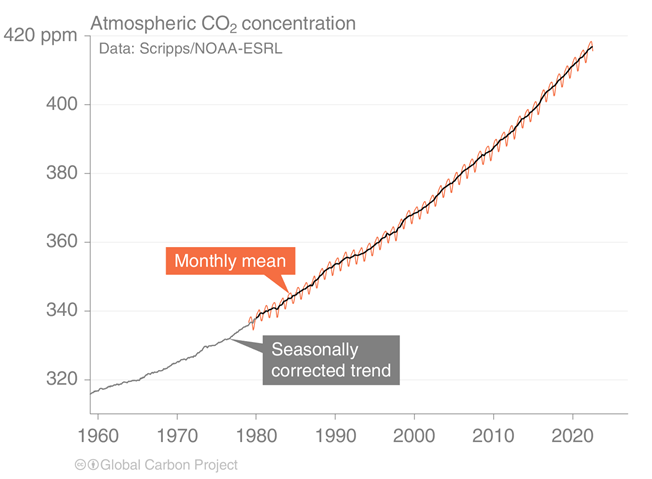Global Carbon Budget 2022
1E. Cuevas, 1O.E. García, 1P.P. Rivas, and 2S.F. León-Luis
1Izaña Atmospheric Research Centre (IARC), State Meteorological Agency of Spain (AEMET), Spain
2TRAGSATEC, Spain
Contact: ecuevasa@aemet.es
The update of the Global Carbon Balance 2022, prepared by the Global Carbon Project, was presented on 11 November during the 27th Conference of the Parties to the United Nations Framework Convention on Climate Change (COP27) held in Sharm-el-Sheikh (Egypt). This reference report, which has been updated annually since 2006 and in which more than 70 international institutions and research organisations participate, has the main objective of giving a global vision of the carbon cycle, taking into account its natural or anthropogenic origin and the reabsorption processes that take place in the Earth-atmosphere system [1]. The Global Carbon Project is part of the Future Earth research initiative and the World Climate Research Programme (WCRP).
The most important conclusion of the document is the absence of any signs that emissions of carbon dioxide (CO2), the main greenhouse gas, are decreasing. Quite the contrary, in 2022, total CO2 emissions will reach a new record of 40.6 Gigatonnes (GtCO2). This is slightly higher than in 2021 with 40.2 GtCO2, but lower than the emission of 40.9 GtCO2 in 2019. According to the Global Carbon Project, the amount of CO2 that can still be emitted into the atmosphere without breaching the climate targets of the Paris Agreement, which aims to limit global temperature rise to 2°C or even 1.5°C this century, have been reduced to 1230 and 380 GtCO2, respectively. At the current rate of emissions, these reference thresholds could be exceeded in as little as 30 and 9 years, respectively. On a positive note, the report highlights that total annual CO2 emissions have not increased significantly since 2015, in contrast to previous years. This is due to the increase in fossil CO2 emissions being partly compensated by the decrease of global net CO2 emissions from land-use change (Figure 1).
According to data from the Global Carbon Project, fossil CO2 emissions will increase globally by 1.0% to 36.6 GtCO2 in 2022. By sources, emissions associated with the use of oil (+2.2%) and coal (+1.0%) will increase, while emissions associated with the use of natural gas (-0.2%) and cement production (-1.6%) will decrease. Considering emitters, only the European Union (-0.8%) and China (-0.9%) will decrease their emissions, increasing in the rest of the world. The latest update of the Global Carbon Balance 2022 does not provide estimated emissions by country, but grouped by major emitters. However, according to the data used to estimate 2022 emissions, Spain emitted 233.65 MtCO2 in 2021, which represents 0.6% of the total emitted that year. On the other hand, global CO2 emissions due to land-use change are 3.9 GtCO2 in 2022, 1% lower than in the previous year. Deforestation, with 6.7 Gt CO2, is the main driver of these emissions, which are partly compensated by reforestation and wood reuse programmes. As Figure 1 displays, the annual emission from land-use change shows a slight downward trend over the last two decades. However, this is difficult to confirm due to the large uncertainty associated with the measurement.

Figure 1. Total annual CO2 emissions (red), fossil CO2 emissions (black) and land-use change emissions (yellow) between 1959 and 2022. The shaded areas represent the associated uncertainty. Figure adapted from [2].
The current imbalance between CO2 emitted and sequestered is causing the atmospheric CO2 concentration increases, reaching a global average value of 417.2 parts per million (ppm) in 2022 [3, 4] (Figure 2), although regional records are higher. Continuous observations from background stations (in very clean atmospheric conditions) of the World Meteorological Organisation's Global Monitoring Programme, such as the Izaña Observatory in Tenerife (IZO, Spain, AEMet) or the Mauna Loa Observatory in Hawaii (MLO, USA, NOAA) simultaneously show that 421 ppm has already been exceeded in the spring of 2022, with interannual increases of 2.3 and 1.9 ppm with respect to 2021 [5-6]. These values are close to the 2.5 ppm increase in global average atmospheric CO2 concentration reported by the Global Carbon Balance 2022. Current records are 50% higher than the pre-industrial reference levels of 280 ppm (in 1750).
The natural sinks of atmospheric CO2, i.e. oceanic and terrestrial ecosystems, continue to absorb about half of the emissions, despite the negative impact of climate change on these ecosystems [7]. Global warming and its climatic consequences have reduced the CO2 sequestration capacity of oceanic and terrestrial sinks by 4% and 17%, respectively, during the decade 2012-2021. Thus, the oceans have captured on average 10.5 GtCO2/year during the decade 2012-2021 (26% of total CO2 emissions) and a similar absorption value is estimated for 2022. On the other hand, the increased presence of CO2 in the atmosphere has favoured a higher capture by vegetation of up to 12.4 GtCO2 by 2022, with the average absorption during the decade 2012-2021 equal to 11.4 GtCO2/year (29% of total CO2 emissions). The total CO2 emission in 2022 (40.6 GtCO2) is approximately 90% from fossil emissions (36.6 GtCO2) and 10% from land-use change emissions (3.9 GtCO2).

Figure 2. Global mean atmospheric surface CO2 concentration (orange line) and seasonally adjusted trend (black line) over the period 1959-2022. Data provided by Scripps Institution of Oceanography (https://scripps.ucsd.edu/) up to 1980 and by the Earth System Research Laboratory of the US National Oceanic and Atmospheric Administration (ERSL-NOAA, www.esrl.noaa.gov/) up to 2022. Figure adapted from [2].
To reach zero emissions by 2050, the Global Carbon Project estimates that anthropogenic emissions need to be reduced at a rate of 1.4 Gt CO2/year until 2050. This decrease is similar, see Figure 1, to that caused by the severe restrictions imposed during 2020 due to the Covid-19 pandemic, which illustrates the magnitude and complexity of the action required.
The European Union has set environmental protection as one of its priorities to mitigate the risks of climate change, with the aim of making Europe the first carbon-neutral continent by 2050 [8]. Along these lines, the European Commission and the member countries have promoted the creation of the European research infrastructure Integrated Carbon Observatory System (ICOS), which seeks to increase knowledge of the carbon cycle based on observations of greenhouse gases in terrestrial, oceanic and atmospheric ecosystems, while evaluating the efficacy of the regulations established to mitigate greenhouse gas emissions.
In January 2021, Spain officially joined this network, with the atmospheric station IZO and the oceanic station CanOA-VOS. The national network, ICOS-Spain, is in a process of growth and, to this end, has incorporated the El Arenosillo atmospheric station into its network in 2022 and expects to start incorporating the Majadas de Tiétar ecosystem station and the ESTOC oceanic station in 2023.
References:
[1] Global Carbon Budget 2022, by Pierre Friedlingstein, Michael O'Sullivan, Matthew W. Jones, Robbie M. Andrew, Luke Gregor, Judith Hauck, Corinne Le Quéré, Ingrid T. Luijkx, Are Olsen, Glen P. Peters, Wouter Peters, Julia Pongratz, Clemens Schwingshackl, Stephen Sitch, Josep G. Canadell, Philippe Ciais, Robert B. Jackson, Simone R. Alin, Ramdane Alkama, Almut Arneth, Vivek K. Arora, Nicholas R. Bates, Meike Becker, Nicolas Bellouin, Henry C. Bittig, Laurent Bopp, Frédéric Chevallier, Louise P. Chini, Margot Cronin, Wiley Evans, Stefanie Falk, Richard A. Feely, Thomas Gasser, Marion Gehlen, Thanos Gkritzalis, Lucas Gloege, Giacomo Grassi, Nicolas Gruber, Özgür Gürses, Ian Harris, Matthew Hefner, Richard A. Houghton, George C. Hurtt, Yosuke Iida, Tatiana Ilyina, Atul K. Jain, Annika Jersild, Koji Kadono, Etsushi Kato, Daniel Kennedy, Kees Klein Goldewijk, Jürgen Knauer, Jan Ivar Korsbakken, Peter Landschützer, Nathalie Lefèvre, Keith Lindsay, Junjie Liu, Zhu Liu, Gregg Marland, Nicolas Mayot, Matthew J. McGrath, Nicolas Metzl, Natalie M. Monacci, David R. Munro, Shin-Ichiro Nakaoka, Yosuke Niwa, Kevin O'Brien, Tsuneo Ono, Paul I. Palmer, Naiqing Pan, Denis Pierrot, Katie Pocock, Benjamin Poulter, Laure Resplandy, Eddy Robertson, Christian Rödenbeck, Carmen Rodriguez, Thais M. Rosan, Jörg Schwinger, Roland Séférian, Jamie D. Shutler, Ingunn Skjelvan, Tobias Steinhoff, Qing Sun, Adrienne J. Sutton, Colm Sweeney, Shintaro Takao, Toste Tanhua, Pieter P. Tans, Xiangjun Tian, Hanqin Tian, Bronte Tilbrook, Hiroyuki Tsujino, Francesco Tubiello, Guido R. van der Werf, Anthony P. Walker, Rik Wanninkhof, Chris Whitehead, Anna Willstrand Wranne, Rebecca Wright,Wenping Yuan, Chao Yue, Xu Yue, Sönke Zaehle, Jiye Zeng, and Bo Zheng (2022), Earth System Science Data, 14, 4811–4900, 2022, DOI: 10.5194/essd-14-4811-2022.
[2] https://www.globalcarbonproject.org/carbonbudget/22/presentation.htm
[3] http://www.esrl.noaa.gov/gmd/ccgg/trends/
[5] IPCC, 2021: Climate Change 2021: The Physical Science Basis. Contribution of Working Group I to the Sixth Assessment Report of the Intergovernmental Panel on Climate Change[Masson-Delmotte, V., P. Zhai, A. Pirani, S.L. Connors, C. Péan, S. Berger, N. Caud, Y. Chen, L. Goldfarb, M.I. Gomis, M. Huang, K. Leitzell, E. Lonnoy, J.B.R. Matthews, T.K. Maycock, T. Waterfield, O. Yelekçi, R. Yu, and B. Zhou (eds.)]. Cambridge University Press, Cambridge, United Kingdom and New York, NY, USA, In press, doi:10.1017/9781009157896.
[6] https://icos-spain.aemet.es/node/36
[7] https://ec.europa.eu/info/strategy/priorities-2019-2024/european-green-deal_es
